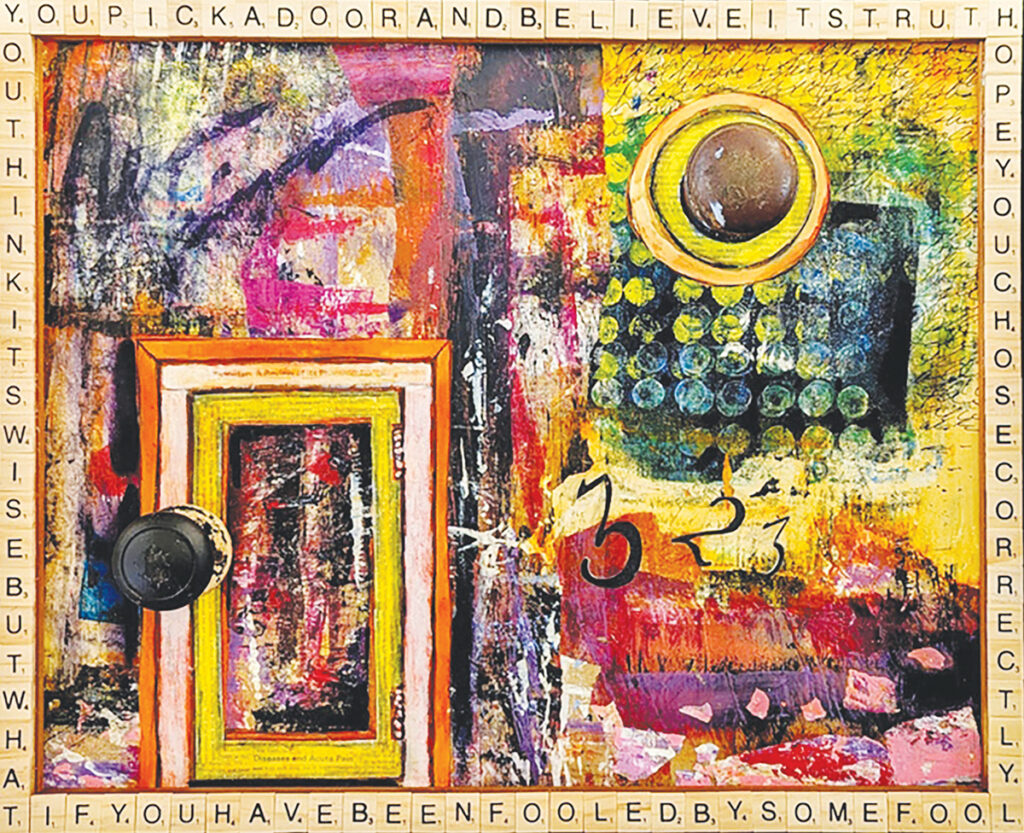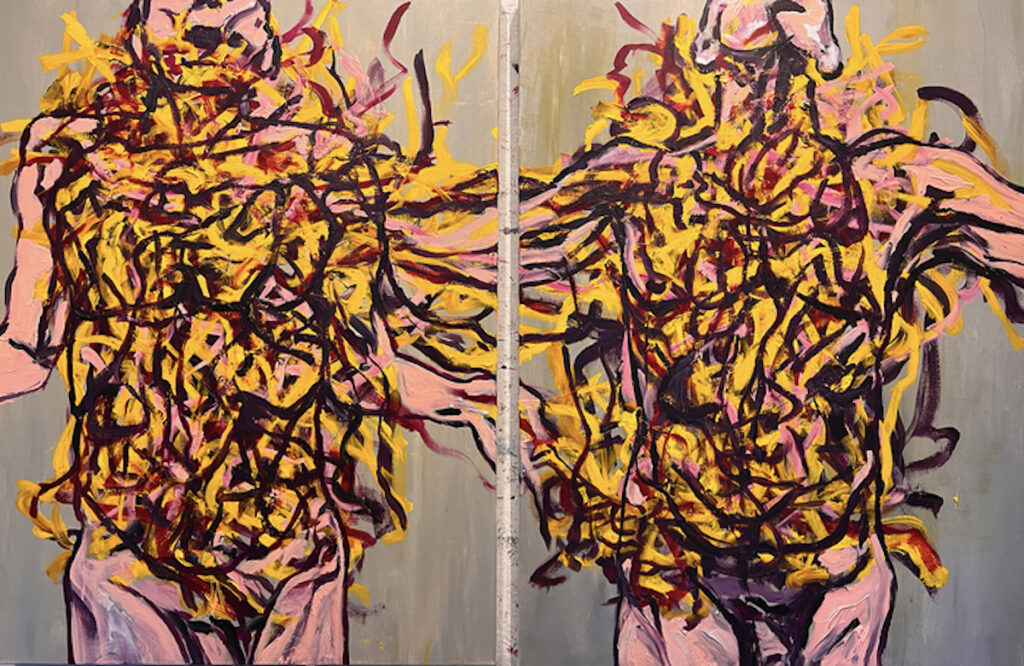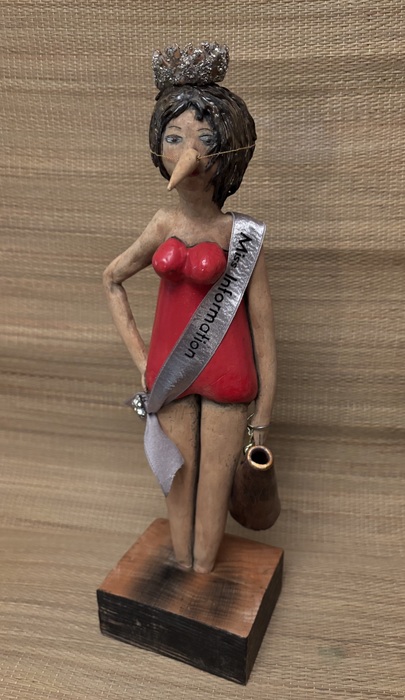
ADRIAN — Working artists must constantly ask themselves, “Am I clear and true in what I’m expressing?” But clarity and truth can be hard to find, especially today.
Recently, artists in our region were presented a timely challenge: to create work about misinformation — things commonly believed but not actually true, one-time facts presented out of context, propaganda, deep fakes, optical illusions and spatial confusion. The results are presented in a new exhibit at the Adrian Center for the Arts.
“The works reflect a world where information comes fast and from a variety of sources,” said Valerie Herr, executive director of the ACA. “It’s more important now to discern truth from lies. But misinformation is difficult to fathom. Can you believe what you read? Do you believe what you see? Who do you trust?”
Of 87 works submitted, 36 were selected for display by juror Sally Rose. Rose holds a Master of Fine Arts degree in textiles from Indiana University and served as head of fiber arts at Central Michigan University. She commended the ACA for giving artists an opportunity to comment on this timely subject.
“It’s always exciting to see what art work will be submitted and how individuals will interpret a theme for a show,” Rose said. “ ‘Misinformation’ left the door wide open.”

The following works exemplify that theme.
Renee Batt’s “Self-presentation,” a sterling silver and jasper pendant, is an example of how a sunny exterior can be deceiving. The golden stone contrasts with a pierced flame image inside. “The outside represents what we allow the world to see of us,” Batt describes. “When open, the pendant represents how we feel inside — sometimes a jumbled mess, and other times we can pull it together and let ourselves shine.”
In Pi Benio’s “Democracy” (clay and mixed media), a large lead-like fishing sinker, hung from a pulley and chain, commemorates an event in Washington D.C. A clue is stamped on the weight — 1621 — referencing the Jan. 6, 2021 storming of the U.S. Capitol Building. “I debated dividing the number to make it more pronounced,” Benio explained, “but decided to leave the mystery open to interpretation — just like our current ‘news,’ where opinion trumps fact.”
Alisa Clark’s “Fooled By Some Fool” (found objects, acrylic, wood and collage), explores disinformation and blind choices. Its surreal dreamscape is punctuated by a pair of doorknobs and framed by a cryptic Scrabble-tile message.
Echoing the appearance and texture of birch bark, Brianna Deterling’s “The Illusive,” a lidded glazed stoneware vessel, plays a looks-can-deceive trick, challenging our assumptions about material and authenticity. “Most of my work ends up being ‘trompe l’oeil’ (fool-the-eye) based on the textures and glazing techniques I use,” the artist explained. But a look inside reveals its true identity: ceramic.
In Ryan Lewis’ video and sound composition, “They the People,” the artist explores symbols and their meanings. A soft violin soundtrack is paired with flowing color lines creating the impression of the American flag. Then comes dissonance, glitches and literal bugs — “a loosely-connected fabric that hovers precariously between order and chaos,” Lewis describes.
In Peter Sparling’s “Thick As Thieves” (acrylic on canvas), twin images represent “our bodies in crisis, under stress or coming apart, according to the prevalent imagery that floods the visual media marketplace,” the artist explains. “The body splits and replicates itself; internal viscera become a tangled bundle of circuitry exposed to an indifferent world.”

Ron Suddendorf’s “Hiking the Appalachian Trail” is tiny enough to fit in your pocket. But the artist commemorated a ripped-out-of-the-news, very large lie. He hand-engraved a South Carolina state quarter adding an outline of Argentina, where the state’s former Gov. Mark Sanford and his girlfriend were hiding for six days. At that time, the governor claimed he was hiking the Appalachian Trail.
Jan Thomas’ “Mis(s) Information” (stoneware, mixed media and wood), humorously depicts a pageant winner, complete with bathing suit, crown and sash — and is another small work big on content. The artist captures the trappings of beauty and authority (the megaphone) and displays it all on a pedestal. The winning “Miss” also features a removable Pinocchio nose.
The “Misinformation” exhibit runs from April 14 to May 17 in the ACA’s Building 46 Gallery, located on the PlaneWave Instruments campus, 1375 North Main St., Adrian. Gallery hours are 1 to 4 p.m. Thursday through Sunday.
A closing reception will be held at the ACA gallery on Saturday, May 17, from 2 to 4 p.m.
Founded in 2015, Adrian Center for the Arts provides visual art education and enrichment to people of all ages and abilities through classes, workshops, exhibitions and studios. For more information, call 517-759-3005 or go to adriancenterforthearts.org.
Note: The closing date has been corrected from the print version of this story.

